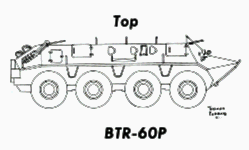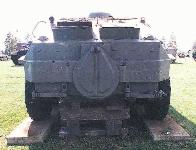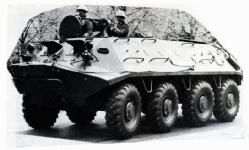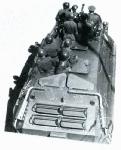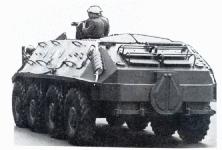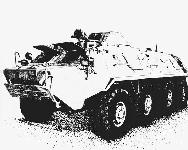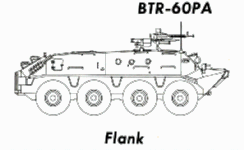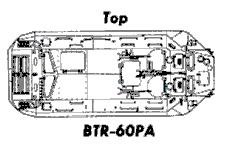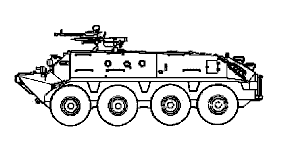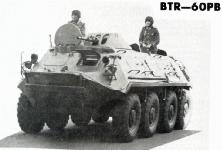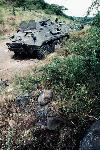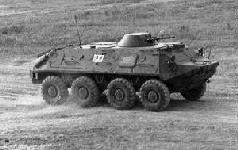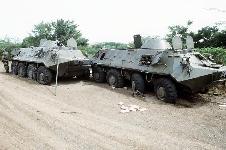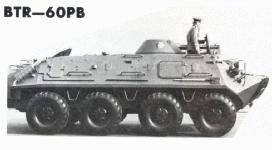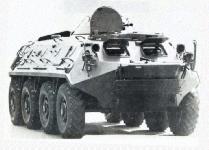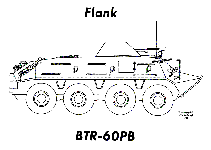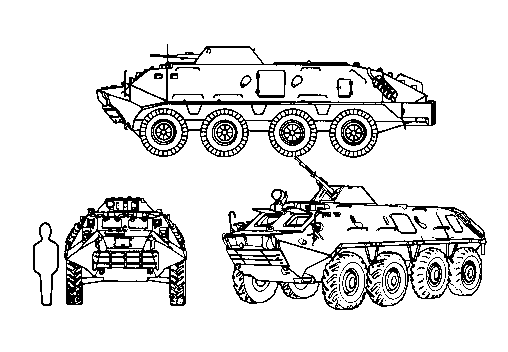
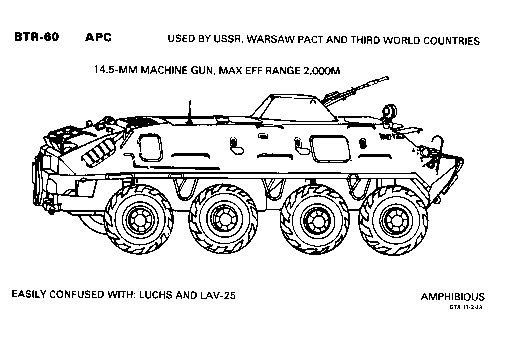




The BTR-60PB performs well cross-country in conditions that favor wheels. On land or water, the vehicle is steered by the front two sets of wheels which also have power steering. The boat-shaped hull with sloped sides provides good swimming capability and helps deflect hostile fire. The BTR-60PB has a searchlight and IR equipment, giving it a night fighting capability.
The BTR-60PB is an eight-wheel-drive vehicle with a long, boat-like hull with well-sloped armor on the sides and overhead armor cover. The hull is of all-welded steel construction, with the driver and commander seated at the front, a personnel compartment in the mid-section, and the engine compartment at the rear of the hull. The BTR-60 has a fully enclosed troop compartment on top of which is a one-man turret. The small conical turret, placed over the second set of wheels, is identical to the one fitted on the BRDM-2. It mounts coaxial 14.5-mm KPV and 7.62-mm PKT machine guns to right, with a telescopic sight mounted coaxially on the left. The crew use two semicircular hatches forward of the turret, and a pair of rectangular hatches aft of the turret for access by up to eight passengers. Three firing ports are located on either side of the troop compartment.
This eight-wheel-drive vehicle has evenly spaced wheels, except for a slightly larger space between the second and third wheels. The tires have the centralized pressure regulation system common to Soviet wheeled APCs, and are partially filled with a foam-rubber-like substance. All eight wheels are powered, and the first four which are used for steering, are power-assisted. The rear-mounted power plant employs a pair of 6-cylinder 90-hp gasoline engines mounted at the rear of the hull. The first and third axles are powered through the transmission of the right engine and the second and fourth axles through the transmission of the left engine. The BTR-60P is fully amphibious, propelled by a single water-jet mounted at the rear of the hull.
Although its armor is thicker than that of older model APCs, the BTR-60PB is vulnerable to HE fragmentation as well as small arms fire. The tires are extremely vulnerable to puncture. Soft ancillary equipment (antennas and integral fuel tanks) are vulnerable to destruction by field artillery weapons. Troops must mount and dismount through the top hatches, which exposes them to fire. A notable vulnerability is that passengers have to exit the vehicle through top hatches, which makes them vulnerable to fires. Also, gunners must be at least shoulder high out of the vehicle to operate the mounted weapons.
The BTR-60PB first appeared in 1965 as the third modification in the BTR-60P series of APCs. It was preceded in 1961 by the open-topped BTR-60P and in 1964 by the BTR-60PK (also known as BTR-60PA) which added overhead armor cover but lacked the turret of the BTR-60PB. Later modifications are the BTR-60PU command vehicle, with a special canvas top and additional radios, and the Forward Air Control Vehicle, a modified BTR-60PB with a large Plexiglas window replacing the coaxial machine guns in the turret and a large portable generator mounted on the rear deck. All versions in the series are still in service, although the BTR-60P and 60PK models are seldom seen today in first-line units. The BTR-60PB has been exported to many countries, including North Korea and most of the Warsaw Pact. There are also Polish and Czech versions of this vehicle. Since 1978 the BTR-70 has begun to replace the BTR-60PB.
Another BTR-60 variant, the artillery command and reconnaissance vehicle (ACRV) M1 979(2), is used as a command observation post (COP) vehicle in towed artillery batteries and battalions.
Specifications | |
| Alternative Designations | BTR-60-PK |
| Date of Introduction | 1963 |
| Proliferation | At least 30 countries (including variants) |
| Description | |
| Crew | 2 |
| Troop Capacity | 12 |
| Combat Weight (mt) | 10.1 |
| Chassis Length Overall (m) | 7.22 |
| Height Overall (m) | 2.06 |
| Width Overall (m) | 2.82 |
| Ground Pressure (kg/cm 2 ) | INA |
| Drive Formula | 8 x 8 |
| Automotive Performance | |
| Engine Type | 2 x 180-hp Gasoline |
| Cruising Range (km) | 500 |
| Speed (km/h) | |
| Max Road | 80 |
| Max Off-Road | 60 |
| Average Cross-Country | INA |
| Max Swim | 10 |
| Fording Depths (m) | Amphibious |
| Radio | INA |
| Protection | |
| Armor, Turret Front (mm) | 7-9mm hull front (no turret) |
| Applique Armor (mm) | N/A |
| Explosive Reactive Armor (mm) | N/A |
| Active Protective System | N/A |
| Mineclearing Equipment | N/A |
| Self-Entrenching Blade | N/A |
| NBC Protection System | Collective |
| Smoke Equipment | N/A |
| ARMAMENT | |
| Main Armament | |
| Caliber, Type, Name | 12.7-mm (12.7 x 108) heavy MG, DShK |
| Rate of Fire (rd/min) | 80-100 (practical) |
| Loader Type | Belt feed |
| Ready/Stowed Rounds | INA |
| Elevation (�) | -10/+80 |
| Fire on Move | Yes |
| Auxiliary Weapons | |
| Caliber, Type, Name | 2 x 7.62-mm machinegun PKT |
| Mount Type | Vehicle top |
| Maximum Aimed Range (m) | 1,500 |
| Max Effective Range (m) | |
| Day | 1,000 |
| Night | N/A |
| Fire on Move | Yes |
| Rate of Fire (rd/min) | 250 practical / 650 cyclic, in 2-10 rd bursts |
| ATGM Launcher | N/A |
| Firing Ports | 3 on each side |
| FIRE CONTROL | |
| FCS Name | N/A |
| Main Gun Stabilization | N/A |
| Rangefinder | N/A |
| Infrared Searchlight | N/A |
| Sights w/Magnification | |
| Gunner | |
| Day | K10-T |
| Field of View (�) | INA |
| Acquisition Range (m) | 1,500 (est) |
| Night | N/A |
| Commander Fire Main Gun | No |


